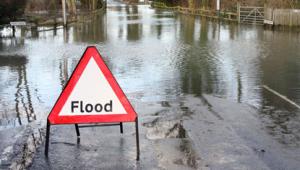13 June 2008
The effects of last summer's floods are still being felt by the hardest-hit regions. Councils planning to minimise the future costs of such events must revisit and update their risk assessments, says Diane Ridley
A year ago, parts of Britain suffered their worst floods for centuries. Today, more than 5,000 families have still not returned to their homes and more than 1,000 are living in caravans. The local authorities affected had to face major challenges, both operational and financial. But what are the long-term financial implications and how should local authorities manage those risks?
The Audit Commission's study, Staying afloat, published last December, looked at the issues around financial planning following the floods in June and July 2007. The report focused on the costs to local authorities, but the impact on communities was much wider than damaged homes, roads and public buildings. Vulnerable and deprived groups tended to be hardest hit, as many did not have any insurance or savings to pay for replacing ruined items.
Other consequences included:
health issues, with some areas reporting higher incidences of depression as a result of the floods
lost days of schooling
some elderly people who had to be moved into residential care have been unable to live independently since
many people lost a lifetime of treasured possessions
some businesses have not recovered
staff time and funds had to be diverted into emergency management and restoration
The floods had a devastating impact on people, property and services, but it could have been even worse. Crucially, they happened just before the school holidays, which limited their impact on education. As it was summer, people who were stranded in their homes without power, or in their vehicles, were in less danger from hypothermia or exposure. After the floods had subsided, properties were quicker to dry out; and living in caravans in summer was perhaps a bit more bearable than in the depths of winter.
The costs associated with the flooding were significant for a small number of authorities. The proportion of the total costs that each authority had to fund from its own resources varied greatly, depending on its
own insurance arrangements, the types of assets damaged and decisions made by different government departments.
Government funding was generous, but the commission found that the lack of predictability and consistency in who received money and why, was unhelpful to local public bodies planning financially for the next emergency.
One year on, it is still not clear who will pay for some of the damage. Claims from some local authorities might not be fully met. The hardest-hit areas are still getting money from central government but the total allocation for each area remains uncertain. In January 2008, the government announced further Flood Recovery Grant funding.
The cash was linked to the numbers of people not yet back in their homes, with a minimum cut-off number and bandings above that. But it is not known whether there will be any further funding on this basis. At the same time, £30m is now available from the European Union, but the formula for distribution to individual councils has yet to be decided.
There is also uncertainty in the public sector insurance market for areas at risk of further flooding. Some authorities affected by last year's flooding are having to pay a lot more money for less comprehensive cover, and some housing associations are reporting serious difficulties in obtaining cost-effective insurance. Yet others report renewing insurance policies that are virtually unchanged.
Some of the authorities affected last year were taken by surprise as heavy rainfall overwhelmed drainage systems, while river flooding was made worse by excessive rainfall on already saturated ground. There is a clear need for better prediction of and planning for flooding linked to excessive rainfall. But this is complex, and at a local level the risk might be small, while prevention and mitigation are expensive. Local public bodies need to weigh up the level of risk they face and the potential cost of such an event happening.
Several of the authorities flooded last year were relatively experienced in dealing with flooding, and this was reflected in their handling of the situation. Those that have carried out some form of post-incident review of their local emergency arrangements will now be better prepared. But severe weather events like these could hit anywhere at any time. Other public bodies need to look to the lessons learnt by the flooded authorities and take a critical look at their own wider business continuity planning, and any appropriate work they could do on prevention and mitigation.
Many of the planning and risk issues will be covered by the imminent final review report from Sir Michael Pitt. His proposals might change the way we all think and prepare in the future. But from a financial point of view we can already identify several actions.
Some changes to planning and flood prevention are dependent on regional or national funding and priorities. But a lot can be done locally, especially if authorities work with residents and businesses to encourage them to look more closely at personal risks and to act accordingly.
Relevant local risks and risk financing decisions need to be reviewed regularly. We might not be able to predict future weather patterns, but we do need to revisit traditional assumptions about the likelihood of local severe weather events.
Offices, homes and public buildings are now full of expensive electronic gadgetry and with the popularity of wooden floors and fitted carpets, contents are now more costly to replace. Risk assessments and asset management decisions might not have taken this into account.
Updated local risk assessments might suggest changes to risk financing arrangements, particularly external insurance. Indeed, insurance companies might require changes. Authorities that have carried out up-to-date assessments and have considered options will be better placed to have a constructive dialogue with their insurers, and will be able to make more informed decisions about levels of excess and premiums.
Natural and man-made disasters are among the ultimate tests of public institutions. Central government can provide guidance and mobilise longer-term support and financial compensation, but only local authorities can deliver on the ground.
The knowledge gained from the flooded areas must be learnt by others before another disaster strikes.
Diane Ridley is head of research at the Audit Commission. She will be on the panel discussing 'When disaster strikes: emergency planning — what price safety?' at the CIPFA conference on Thursday, June 19.
PFjun2008



















